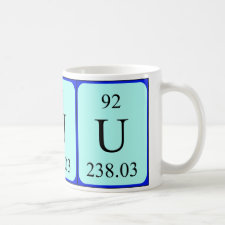
Authors: Metilda P, Gladis JM, Venkateswaran G, Prasada Rao T
Article Title: Investigation of the role of chelating ligand in the synthesis of ion-imprinted polymeric resins on the selective enrichment of uranium(VI).
Publication date: 2007
Journal: Analytica Chimica Acta
Volume: 587
Issue: (2)
Page numbers: 263-271.
DOI: 10.1016/j.aca.2007.01.039
Alternative URL: http://www.sciencedirect.com/science/article/B6TF4-4MW322B-C/2/c8d2af4ac9188d79fc159bb2168e362e
Abstract: Uranyl ion-imprinted polymeric (IIP) resins were prepared by dissolving stoichiometric amounts of uranyl nitrate and selected chelating ligands, viz. salicylaldoxime, catechol, succinicacid, 5,7-dichloroquinoline-8-ol and 4-vinyl pyridine in 2-methoxy ethanol (porogen) and copolymerizing thermally in the presence of 2-hydroxyethylmethacrylate (HEMA) and ethyleneglycol-dimethacrylate (EGDMA), using 2,2'-azobisisobutyronitrile (initiator). Again, IIP resins were also prepared on similar lines by utilizing ternary [uranium-non-vinylated ligand-vinylated ligand (4-vinyl pyridine)] complexes. Non-imprinted polymeric resins were identically prepared in both cases without the use of uranyl imprint ion. The percent enrichment and retention capacity studies showed significant imprinting effect in all cases. However, ion-imprinted polymeric resins formed with succinic acid (SA) or 5,7-dichloroquinoline-8-ol (DCQ) and 4-vinylpyridine (VP) alone gave quantitative enrichment and various parameters that influence the enrichment and elution were then optimized. The percent enrichment of uranium from synthetic seawater solutions was found to be 25.0 ± 0.5 and 83.0 ± 0.8 for SA-VP and DCQ-VP systems, respectively. The DCQ-VP-based IIP resins were successfully tested for the recovery of uranium from real seawater samples
Template and target information: urnanium, uranyl ion, UO22+
Author keywords: Ion-imprinted polymers, preconcentration, Chelating ligand, Uranium recovery, analysis, seawater



Join the Society for Molecular Imprinting

New items RSS feed
Sign-up for e-mail updates:
Choose between receiving an occasional newsletter or more frequent e-mail alerts.
Click here to go to the sign-up page.
Is your name elemental or peptidic? Enter your name and find out by clicking either of the buttons below!
Other products you may like:
 MIPdatabase
MIPdatabase









